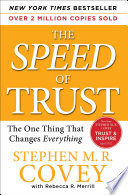

In 'The SPEED of Trust', Stephen M.R. Covey emphasizes that trust is not just a social virtue but a crucial economic driver. Trust reduces transaction costs, accelerates processes, and enhances collaboration. When trust exists within an organization or between individuals, the need for oversight diminishes, leading to greater efficiency and productivity. Covey illustrates how high-trust environments foster innovation and adaptability, while low-trust environments often result in bureaucratic slowdowns and increased costs. The book suggests that leaders should actively cultivate trust to unlock the full potential of their teams and organizations.
Continue readingCovey outlines the Five Waves of Trust, which are layers that build upon each other: Self Trust, Relationship Trust, Organizational Trust, Market Trust, and Societal Trust. Each wave represents a different level at which trust can be established and nurtured. Self Trust is about personal integrity and competence, while Relationship Trust focuses on interpersonal relationships. Organizational Trust deals with the culture and systems within a company, Market Trust pertains to the brand and reputation in the marketplace, and Societal Trust relates to the broader community and its perception of the organization. Understanding these waves helps leaders identify where trust may be lacking and how to address it effectively.
Continue readingCovey identifies 13 specific behaviors that high-trust leaders exhibit. These include demonstrating respect, creating transparency, righting wrongs, showing loyalty, delivering results, and extending trust to others. Each behavior is crucial for building and maintaining trust within teams and organizations. For instance, showing loyalty means defending team members in their absence, while delivering results builds credibility. The book provides actionable insights on how leaders can embody these behaviors to foster a culture of trust, ultimately leading to improved performance and morale.
Continue readingOne of the key assertions in 'The SPEED of Trust' is that trust is quantifiable. Covey introduces the Trust Tax and Trust Dividend concepts, where low trust incurs a 'tax' on productivity and efficiency, while high trust generates a 'dividend' that enhances performance. By measuring trust levels within an organization, leaders can identify areas for improvement and track progress over time. This measurement can be done through surveys, feedback mechanisms, and performance metrics, making trust an actionable metric that can drive strategic decisions.
Continue readingCovey addresses the inevitable breakdown of trust that can occur in any relationship or organization. He provides a framework for restoring trust, emphasizing the importance of accountability, transparency, and open communication. The process involves acknowledging the breach, taking responsibility, and actively working to rebuild trust through consistent, trustworthy behavior. This idea is particularly relevant in today's fast-paced and often turbulent business environment, where trust can be easily lost but is essential for long-term success.
Continue readingThe title of the book itself highlights the connection between trust and speed. Covey argues that high levels of trust lead to faster decision-making, quicker implementation of ideas, and overall agility within organizations. When trust is present, teams can move forward without the delays associated with excessive checks and balances. This principle is vital for businesses aiming to thrive in competitive markets, where speed and innovation are crucial. Covey provides examples of organizations that have embraced this principle and seen significant improvements in their operational efficiency.
Continue readingFinally, Covey posits that trust is not merely an inherent trait but a skill that can be developed and strengthened over time. By consciously practicing the behaviors associated with high trust and engaging in self-reflection, individuals can enhance their trustworthiness. The book encourages readers to take proactive steps in their personal and professional lives to cultivate trust, demonstrating that anyone can become a high-trust leader with dedication and effort.
Continue reading